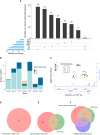Plasma cortisol-linked gene networks in hepatic and adipose tissues implicate corticosteroid-binding globulin in modulating tissue glucocorticoid action and cardiovascular risk
- PMID: 37745713
- PMCID: PMC10513085
- DOI: 10.3389/fendo.2023.1186252
Plasma cortisol-linked gene networks in hepatic and adipose tissues implicate corticosteroid-binding globulin in modulating tissue glucocorticoid action and cardiovascular risk
Abstract
Genome-wide association meta-analysis (GWAMA) by the Cortisol Network (CORNET) consortium identified genetic variants spanning the SERPINA6/SERPINA1 locus on chromosome 14 associated with morning plasma cortisol, cardiovascular disease (CVD), and SERPINA6 mRNA expression encoding corticosteroid-binding globulin (CBG) in the liver. These and other findings indicate that higher plasma cortisol levels are causally associated with CVD; however, the mechanisms by which variations in CBG lead to CVD are undetermined. Using genomic and transcriptomic data from The Stockholm Tartu Atherosclerosis Reverse Networks Engineering Task (STARNET) study, we identified plasma cortisol-linked single-nucleotide polymorphisms (SNPs) that are trans-associated with genes from seven different vascular and metabolic tissues, finding the highest representation of trans-genes in the liver, subcutaneous fat, and visceral abdominal fat, [false discovery rate (FDR) = 15%]. We identified a subset of cortisol-associated trans-genes that are putatively regulated by the glucocorticoid receptor (GR), the primary transcription factor activated by cortisol. Using causal inference, we identified GR-regulated trans-genes that are responsible for the regulation of tissue-specific gene networks. Cis-expression Quantitative Trait Loci (eQTLs) were used as genetic instruments for identification of pairwise causal relationships from which gene networks could be reconstructed. Gene networks were identified in the liver, subcutaneous fat, and visceral abdominal fat, including a high confidence gene network specific to subcutaneous adipose (FDR = 10%) under the regulation of the interferon regulatory transcription factor, IRF2. These data identify a plausible pathway through which variation in the liver CBG production perturbs cortisol-regulated gene networks in peripheral tissues and thereby promote CVD.
Keywords: causal inference; corticosteroid-binding globulin; cortisol; gene networks; systems genetics.
Copyright © 2023 Bankier, Wang, Crawford, Morgan, Ruusalepp, Andrew, Björkegren, Walker and Michoel.
Conflict of interest statement
Authors JB and AR was employed by the company Clinical Gene Networks AB. The remaining authors declare that the research was conducted in the absence of any commercial or financial relationships that could be construed as a potential conflict of interest.
Figures



Similar articles
-
Variation in the SERPINA6/SERPINA1 locus alters morning plasma cortisol, hepatic corticosteroid binding globulin expression, gene expression in peripheral tissues, and risk of cardiovascular disease.J Hum Genet. 2021 Jun;66(6):625-636. doi: 10.1038/s10038-020-00895-6. Epub 2021 Jan 20. J Hum Genet. 2021. PMID: 33469137 Free PMC article.
-
Genome wide association identifies common variants at the SERPINA6/SERPINA1 locus influencing plasma cortisol and corticosteroid binding globulin.PLoS Genet. 2014 Jul 10;10(7):e1004474. doi: 10.1371/journal.pgen.1004474. eCollection 2014 Jul. PLoS Genet. 2014. PMID: 25010111 Free PMC article.
-
Polygenic risk score of SERPINA6/SERPINA1 associates with diurnal and stress-induced HPA axis activity in children.Psychoneuroendocrinology. 2018 Jul;93:1-7. doi: 10.1016/j.psyneuen.2018.04.009. Epub 2018 Apr 13. Psychoneuroendocrinology. 2018. PMID: 29679879
-
Cortisol, Stress, and Disease-Bidirectional Associations; Role for Corticosteroid-Binding Globulin?J Clin Endocrinol Metab. 2024 Aug 13;109(9):2161-2172. doi: 10.1210/clinem/dgae412. J Clin Endocrinol Metab. 2024. PMID: 38941154 Review.
-
Corticosteroid-binding globulin: modulating mechanisms of bioavailability of cortisol and its clinical implications.Best Pract Res Clin Endocrinol Metab. 2015 Oct;29(5):761-72. doi: 10.1016/j.beem.2015.09.001. Epub 2015 Sep 11. Best Pract Res Clin Endocrinol Metab. 2015. PMID: 26522460 Review.
Cited by
-
[Factors and conditions affecting transcortin production and function in blood plasma].Probl Endokrinol (Mosk). 2025 Jul 22;71(3):14-24. doi: 10.14341/probl13483. Probl Endokrinol (Mosk). 2025. PMID: 40734295 Free PMC article. Review. Russian.
-
Impaired SERPIN-Protease Balance in the Peripheral Lungs of Stable COPD Patients.Int J Mol Sci. 2025 Mar 21;26(7):2832. doi: 10.3390/ijms26072832. Int J Mol Sci. 2025. PMID: 40243422 Free PMC article.
-
ATP-binding cassette family C member 1 constrains metabolic responses to high-fat diet in male mice.J Endocrinol. 2024 Jul 3;262(2):e240024. doi: 10.1530/JOE-24-0024. Print 2024 Aug 1. J Endocrinol. 2024. PMID: 38829241 Free PMC article.
References
Publication types
MeSH terms
Substances
Grants and funding
LinkOut - more resources
Full Text Sources
Medical
Molecular Biology Databases
Research Materials
Miscellaneous

